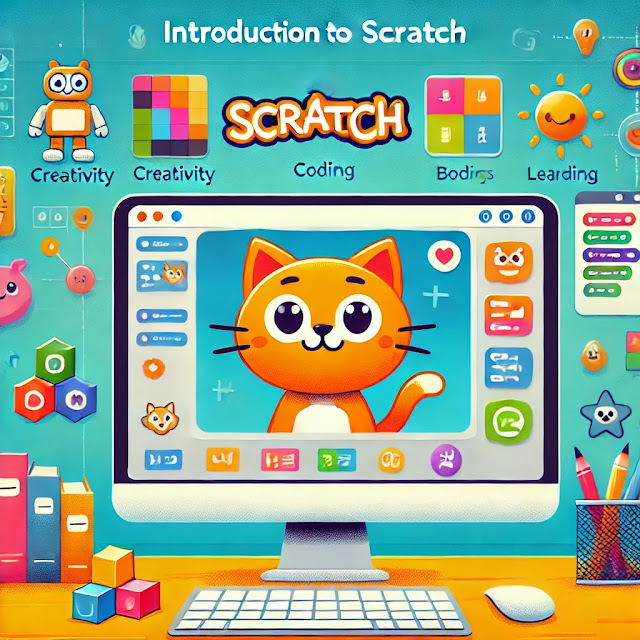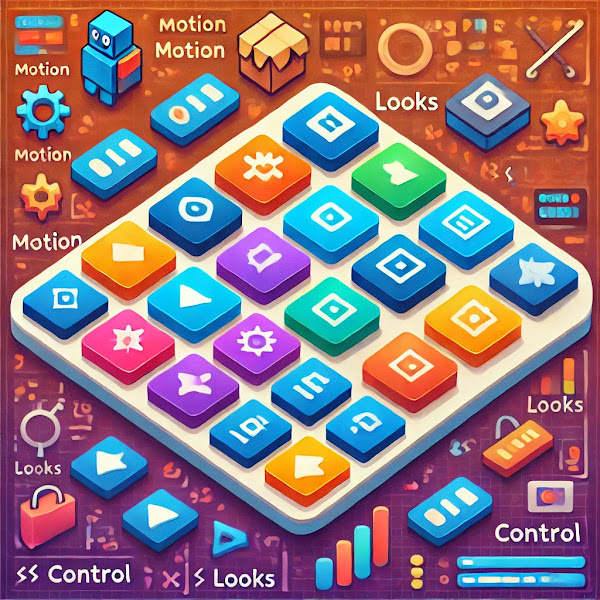Scratch
Scratch
is a block-based visual programming language designed primarily for children
and beginners to learn programming concepts. Below are the key outlines for
understanding Scratch, along with brief descriptions of each:
1. Introduction
to Scratch
Description: Scratch is a free, visual programming language developed by MIT. It uses a drag-and-drop interface where users can build programs by snapping together blocks, making coding simple and accessible. It’s widely used for teaching coding basics and creating interactive stories, animations, and games.
2. Scratch Interface Overview
- Description: The Scratch interface
consists of the following main areas:
- Stage: Displays the output of
your project (e.g., animations, games).
- Sprites Pane: Shows all characters or
objects in the project.
- Blocks Palette: Contains the coding
blocks categorized by functions (motion, control, events, etc.).
- Script Area: The workspace where
blocks are arranged to create scripts.
- Toolbar: Offers tools for saving,
sharing, or managing projects.
3. Scratch Programming Blocks
- Description: Scratch’s programming
blocks are categorized into different types:
- Motion: Blocks for movement and
positioning of sprites.
- Looks: Blocks for controlling
appearance and speech.
- Sound: Blocks to add and manage
sounds.
- Events: Blocks that trigger
actions (e.g., when a key is pressed).
- Control: Blocks for loops,
conditionals, and timing.
- Sensing: Blocks to detect
interactions (e.g., touching other sprites).
- Operators: Blocks for calculations
and logic.
- Variables and Lists: Used to store and
manipulate data.
4. Sprites and Costumes
- Description:
- Sprites are characters or objects
in a Scratch project. Each sprite can have its own scripts and behavior.
- Costumes are different appearances
of a sprite, enabling animations and visual changes.
5. Creating Animations
- Description: Scratch allows users to
create animations by sequencing movements, changing costumes, and using
timing. This introduces learners to the concept of frame-by-frame
animation and event-driven programming.
6. Game Development
- Description: Scratch is widely used for
game development. Users can design sprites, create rules, and implement
interactivity (e.g., scoring, player input, and levels) using blocks like
sensing and control.
7. Using Sounds and Music
- Description: Scratch provides tools to
add, record, and edit sounds. Blocks allow for sound effects, background
music, and interactive audio elements.
8. Event-Driven Programming
- Description: Event-driven programming
is central to Scratch. Events such as "when green flag clicked"
or "when space key pressed" trigger actions, introducing the
concept of responding to user inputs or other conditions.
9. Variables and Data
- Description: Variables are used to
store data, such as scores or player health, while lists can manage
collections of data. These features help learners understand basic data
structures and storage concepts.
10. Collaboration and Sharing
- Description: Scratch enables users to
share their projects on the Scratch community platform, promoting
collaborative learning. Users can remix projects to learn from others and
share ideas.
11. Extensions and Advanced Features
- Description: Extensions in Scratch
provide advanced functionalities, such as:
- Controlling hardware (e.g., micro:bit, LEGO robotics).
- Using text-to-speech.
- Integrating video sensing for interactive projects.
12. Benefits of Scratch in Learning
- Description: Scratch enhances
problem-solving, logical thinking, and creativity. It’s a stepping stone
to more advanced programming languages by teaching foundational concepts
in a beginner-friendly environment.
13. Future Prospects and Applications
- Description: Scratch serves as a
foundation for exploring robotics, IoT, and game design. Its intuitive
design encourages learners to experiment and build real-world
applications.
summary
These outlines provide a comprehensive understanding of Scratch, from its basics to its applications in programming and education. Let me know if you need more details or assistance in any specific area
Scratch programming project
prepare for the following categories
1. Project Type
- Game
- Animation
- Story
- Art
- Simulation
- Music
- Quiz
2. Theme or Genre
- Adventure
- Puzzle
- Platformer
- Racing
- Educational
- Fantasy
- Space
- Animals
3. Features
- Multiplayer
- Interactive
- Scrolling
- AI (Artificial Intelligence)
- Customizable
- Randomized
4. Coding Concepts
- Loops
- Variables
- Conditional Statements
- Sensing
- Broadcasting
- Cloning
Scratch programming project
prepare for the following target audience categories
5. Target Audience
- Kids
- Teens
- Beginners
- Advanced Users
- Educators
- Gamers
6. Tools or Techniques
- Pixel Art
- Pen Tool
- Sprite Animation
- Sound Effects
- Custom Blocks
- Physics Engine
Example Labels for a Game Project:
For a
simple platformer game:
- Platformer
- Adventure
- Scrolling
- Intermediate
- Custom Sprites



No comments:
Post a Comment